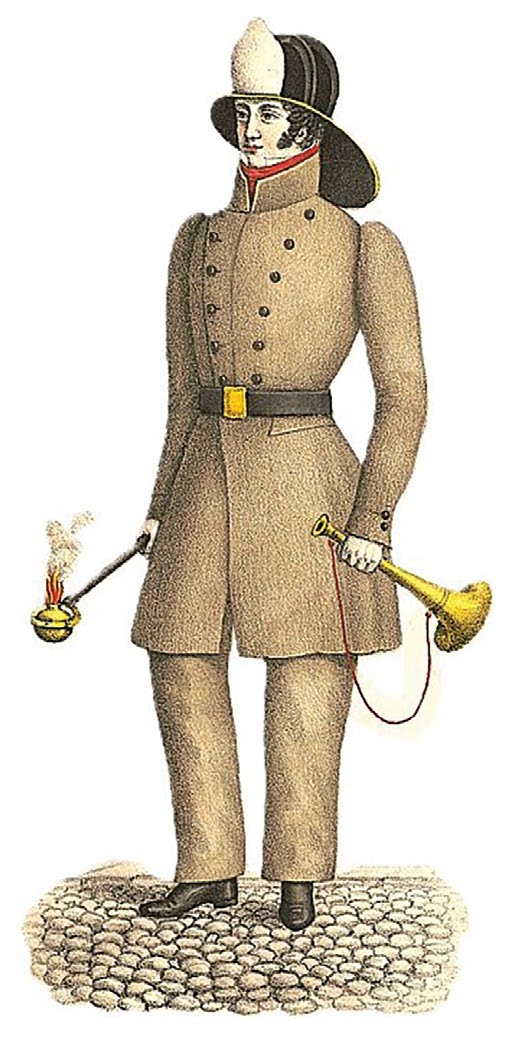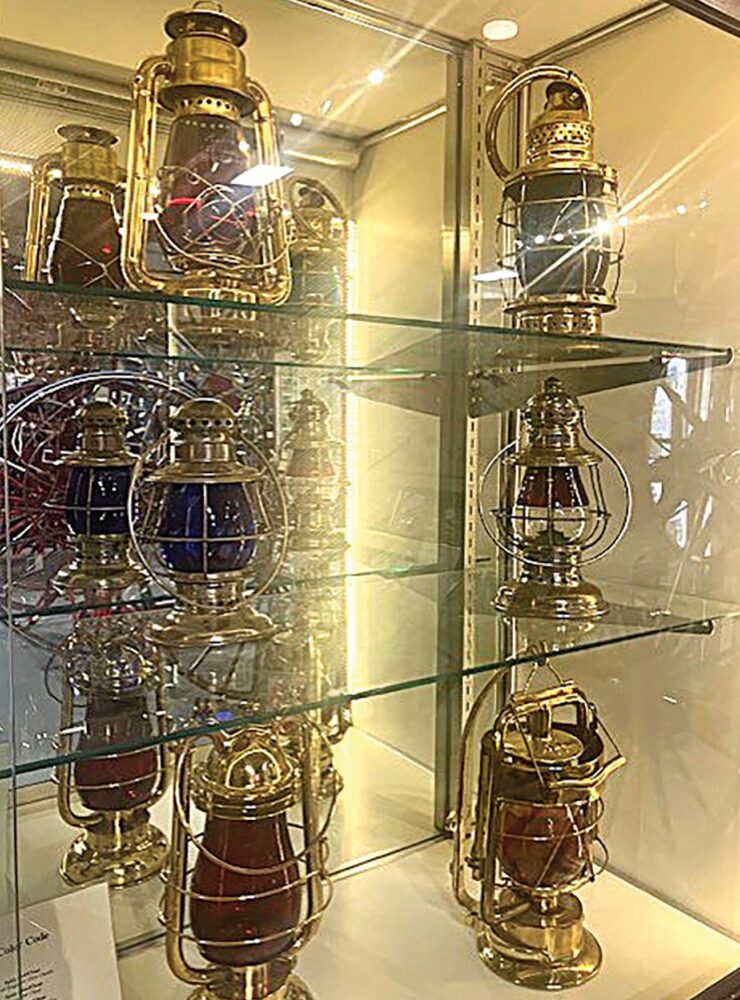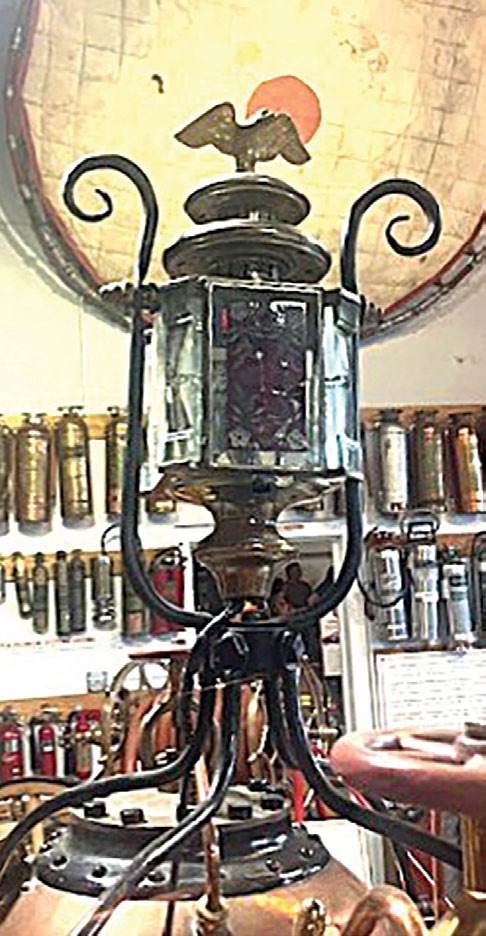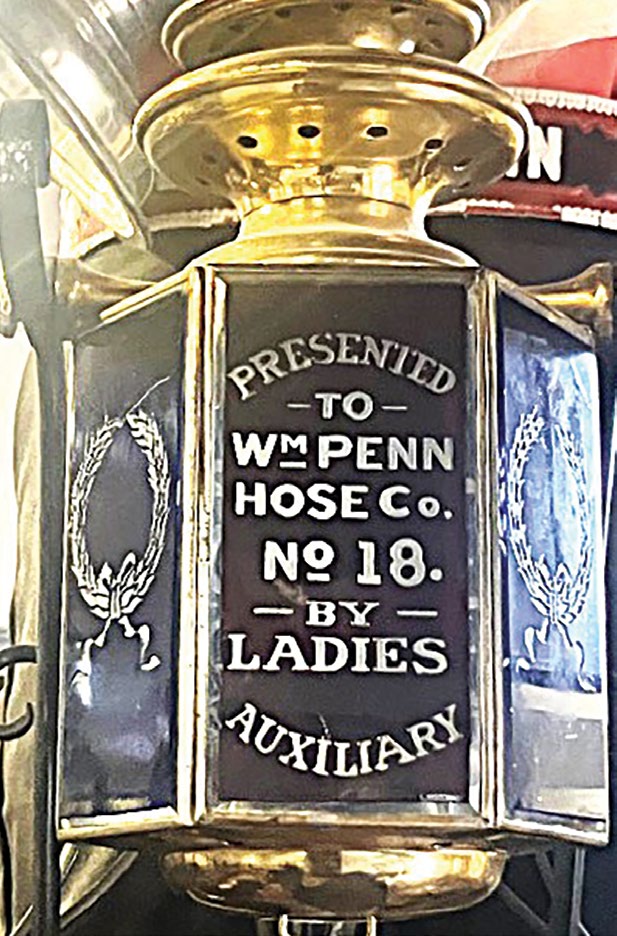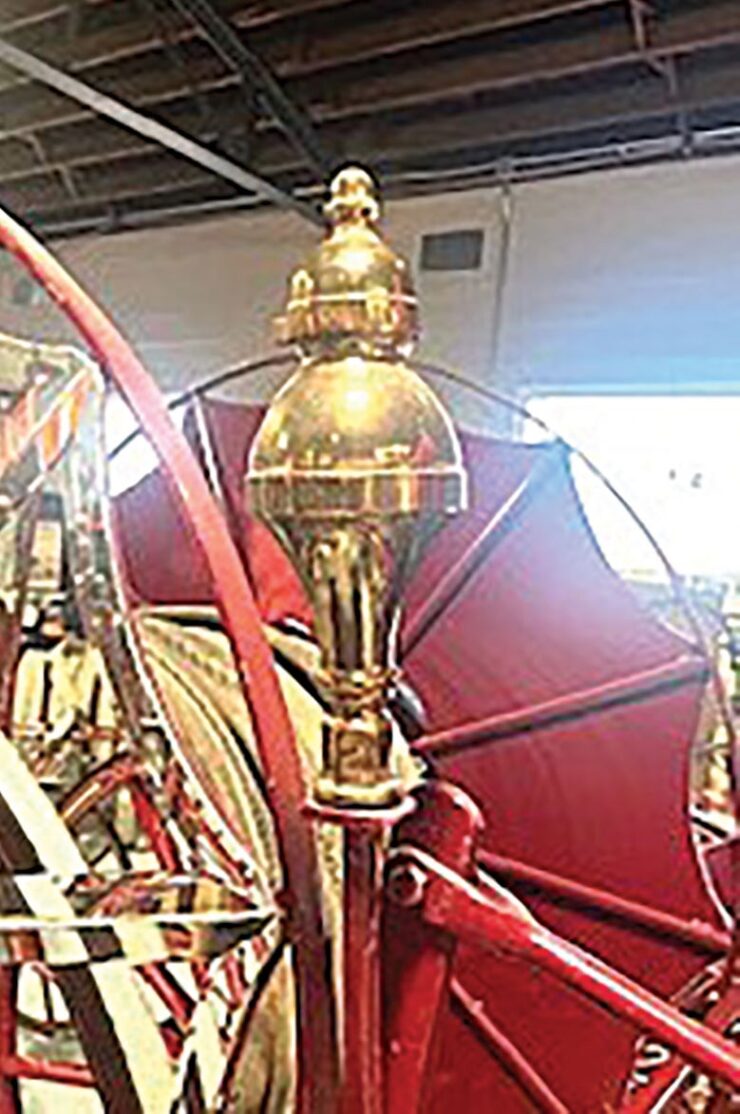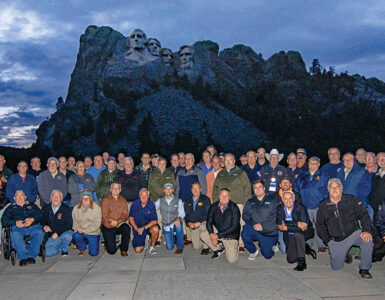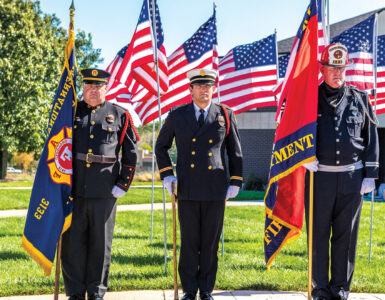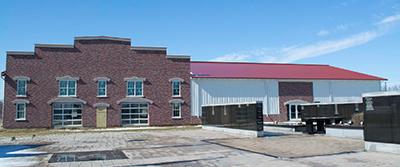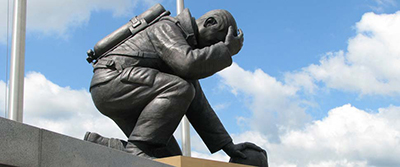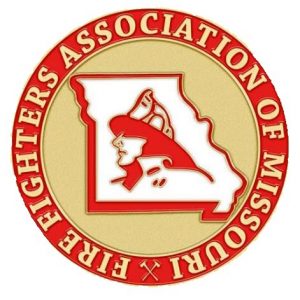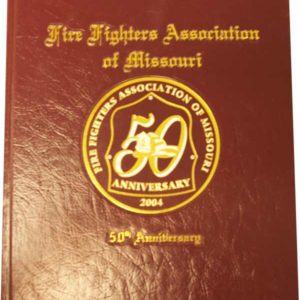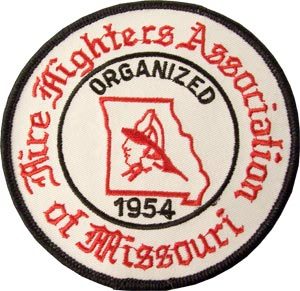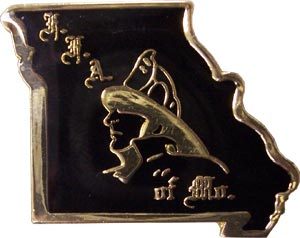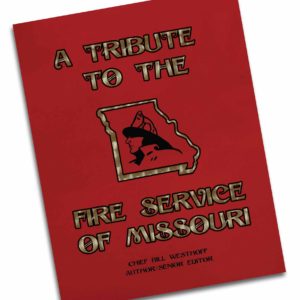A Part of Fire Service History©
In this series, A Part of Fire Service History, a variety of historic fire service apparatus and equipment have been discussed. One item of equipment that has not been covered at any length concerns the ways American Firefighters illuminated fire apparatus or fire scenes at night in the era before electric lights. Examples of the lighting equipment covered in this chapter include: torches, lanterns, and apparatus lamps. Originally, the author titled this chapter the Illumination of Firefighting. Though it is hoped the chapter provides valuable knowledge (illumination) on early American firefighting lighting, the second common definition of illumination, that of providing a means of visible light, is also appropriate.
This chapter will cover the types of lighting equipment and its use by American Firefighters before the development of electric lights. Not only is it a fascinating history, but some of the images of this lighting equipment still has meaning and carries forward on some of the symbols used in fire service “Scrambles” on badges and emblems seen today. This symbol is an often misunderstood and misrepresented historic device in the fire service today.
As in previous chapters, this one draws on extensive archival research from the past. When quoting original documents or referring to “Firefighters” in a historical context, the term “Firemen” is used. The term fireman, or firemen for plural, first came into relevance in regard to people putting out fires in 1714, being traditionally used generally between the 1820s to the 1980s.1 The traditional definition of the term “Fireman” is referenced in an 1841 dictionary as: “A man whose business is to extinguish fires.” 2 In addition, in early American history, local community fire organizations were called a fire company, such as an engine company or hose company. These individual fire companies would come together to fight fire, being the predecessor of what would later become a town’s fire department. Also, the term company in the past and now is used to denote a commercial business, such as a manufacturer of fire equipment. This chapter continues the practice of using antiquated terms when their use is historically appropriate.
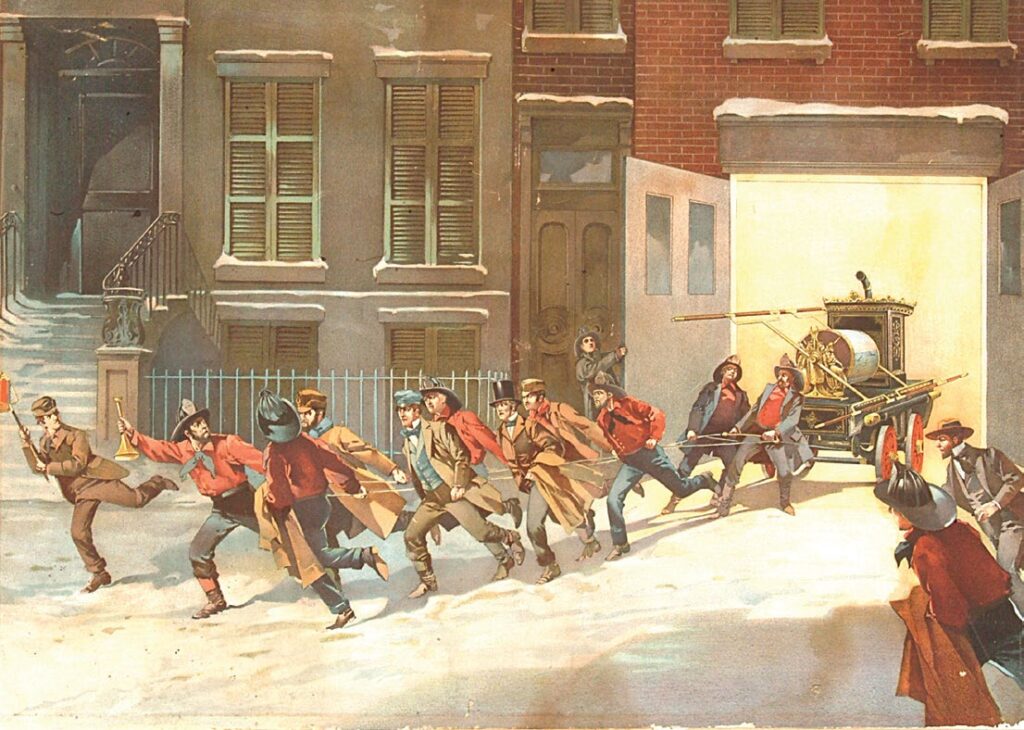
Torches, Lanterns and Apparatus Lamps
Fire or its flame is not always the firefighters’ enemy; it can also be a tool. As was presented in the chapter The Age of Steam Fire Engines, fire heated a water-filled boiler, producing steam that provided the first totally mechanical-powered fire engine pumps. Fire and explosives were also used in situations where buildings were destroyed to make fire breaks to control major conflagrations in the past. Today, wildland firefighters use a technique of fire breaks and backfires to stop or control the expansion of wildland fires. However, a simpler use of fire by early firemen was to produce illumination (light) for nighttime operations or interior search and rescue. In early American settlements, there was no public lighting to light the streets at night. It would not be until around the 1750’s that oil (whale oil) street lights came in to use for public lighting in some towns.3 Gas (coal oil) fueled street lights first came into use in Baltimore in 1817.4 Still, many towns and cities for centuries were poorly illuminated during the night until electric lighting became common in the mid-1900s.
Before the development of automotive (internal combustion engine) powered fire apparatus with electric-generated lights, lanterns or simple torches provided firemen with light to see by at night. In the earliest days of the bucket brigade or handtubs (hand-pump engines), a torch was commonly used and carried by a runner to show the way to the fire. The torchbearer position would become an honored position in fire companies, leading the way for the firefighting forces.
Firemen Torches
Early torches were cylindrical or round tin containers containing tallow and a twisted waxed wick extending from the container. Tallow is rendered animal fat used in cooking or for early candles. Sometimes the containers were painted with markings, the fire company’s name, or stippled with a fire company number. Early open flame torches were sometimes called “Flambeaux.”5 Later torches were made of brass containers that contained coal oil or later kerosene fuel and had a screw on or slip-fit lid. A protruding wick was ignited to provide an open flame for light. Torch containers were usually mounted on a pole that was carried by a torch boy, a fleet young boy of the fire company.6 The term “Torch Bearer” was used when an honored member of the fire company was assigned to carry the torch and lead the way to the fire, or in parades.7 Continued adaptations to the pole mounts consisted of a pivoting hoop and yoke on the end of the pole to allow the container to swing upright when carried at various angles. The pole was usually three to four feet long. Some poles were sharpened on the butt end to enable them to be stuck into the ground at the fire scene. Later versions were more ornate with decorations. Some fire apparatus had loop brackets to slide the torch pole in when carried on the apparatus.
As time passed, fire torches became more stylized and embellished in design. Sometimes, the finely decorated fire service torches were confused with political or election campaign torches of the period. On occasion, they were one in the same. The early firemen used to love to parade their new hand-pump fire apparatus. Sometimes at night, they paraded, drawing a crowd with ringing bells and lighted hand torches. Besides the torch boy, many of the members of the engine company “carried hand-held torches over their shoulders.”8 In addition, because of the great number of volunteer firemen needed to work the brakes (pump hand levers) on the apparatus, these volunteers composed a large political voting block of citizens. They represented their political interest with parades for candidates and other public appearances. Other political groups saw the effect of the bright torches at night and soon had their own torches made or bought them from catalogs, an example being the G. F. Foster, Son & Company in their Campaign Uniforms, Torches and Equipments Catalog from 1896.9 Many of these campaign torches were highly ornate to compete with fire department torches. Thus, the confusion between the two types of antique torches found today.
In some cities, when the fire alarm was sounded during the night, the citizens were required to light candles and place them in their windows to help illuminate the street in order to light the way for the firemen. This aided the volunteer firemen in the dark to make their way to the firehouse, as well as light the streets for the response of the fire company/engine.10
Unique Fire Torches
Early torches were like other early firefighting equipment, such as fire buckets; they were made initially by artisans in the local community. Later, as torches became more specialized for the fire service, fire equipment manufacturers would make and sell them throughout the country.
Besides the more standard fireman hand torches, fire equipment manufacturers came up with some unique adaptations and options. One was the “Improved Hat Torch” by Cairns & Brothers, c. 1890s. The small open torch assembly was designed to be clamped to the top “comb” of the fire helmet or to a parade hat. On the fire helmet, it could be used for both night parades or on the fire scene to identify the location of people working around the apparatus or hose men.11
A unique hand torch was designed to be used for night parades. It was called the “Shaler’s Patented Flash Torch” and was sold by Fred Miller’s Fire Apparatus and Fire Department Supplies, c. 1870s. The hand torch carried upright had a hollow tube in the handle that the fireman could blow through to force air and fuel up through the torch, sending flame supposedly three-feet into the air.12 Thus creating a quite noticeable effect during a night parade. However, one must wonder about the potential fire hazards of this remarkable eye eye-catching spectacle with its spouting flame. An ironic twist of Firemen parading to promote fire protection while creating a potential fire hazard.
Though the “Helmet Torch” might have had some possible use on the fire ground at night, the use for parades, along with the “flash torch,” seems more for showmanship than practical use. But that did not stop the fire equipment manufacturers from coming up with new ideas to cater to the proud firemen and make money.
As many fires in early America occurred at night, the ability of firemen to safely respond to the engine company was dependent on some means of artificial lighting. That light was first provided by simple torches. However, these simple torches came to be viewed as one of the essential tools of the trade of firemen. The respect of the firemen for this simple tool can be seen by its inclusion in the fire tool grouping on early fire service scrambles depicted in insignia and emblems still seen today. A further illumination of the importance of the torch and Fire Scrambles will be discussed later in this chapter.
Hand Lanterns and Pole Lanterns
Oil lamps or lanterns became popular in the late 1700s for use in the home, in time replacing candles. The firemen took notice and soon replaced their tallow torches with various types of lanterns. The pole lantern was similar to the torch poles. Replacing the open torch configuration with an oil lamp or lantern hanging from the pole and carried by the torch boy or torch bearer.
So what is the difference between a lamp and a lantern? A lantern is defined as: “a usually portable protective case for a light with transparent openings.”13 The word lantern comes from the Latin word “lanterna,” meaning lamp, so early on, perhaps an interchangeable term.14 However, for our discussion, a lantern is specifically designed to be used outdoors, is portable, and has the flame protected from the elements by various protective enclosures. The term lamp in this chapter generally refers to fixed apparatus-mounted lighting that will be covered in the next section.
Whale oil lanterns became popular in America around the late 1700s and were quickly adopted for fire brigades. Usually called a hand lantern, they were made of tin, copper, or brass and constructed with a protective cover or cage surrounding the mica panels or glass globe containing the flame and a metal bale or stiff wire loop as a carrying handle. Lanterns specific for fire department use sometimes had attachment points for temporary mounting to the apparatus for light during the response and then could be removed for use at the fire scene.
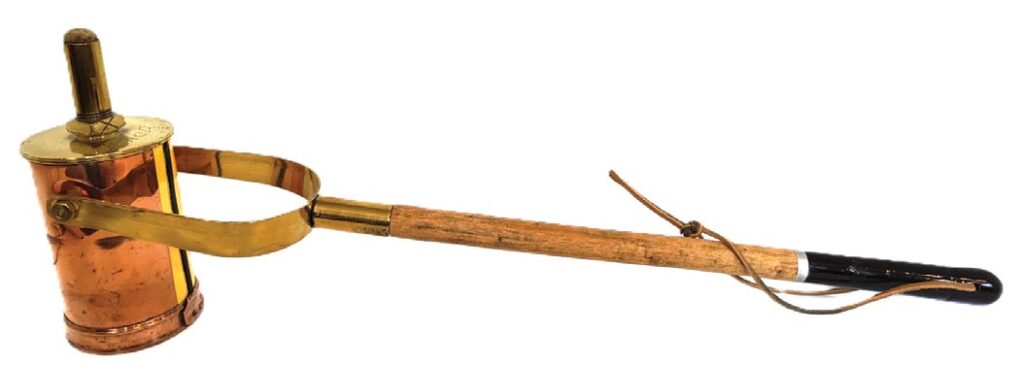
To improve the appearance of the fire lantern, the lantern body was often painted or plated with silver or nickel. Special details were also found on some lanterns with engraving of personal names on the globe or lantern body. The lantern globe, normally clear, could also be colored. From listings in an antique Cairns and Brother Catalog of fire equipment, the glass protective globe could be specified for lanterns at an extra cost in various colors, including: white, blue, green, red, or split colors, half clear with: red, green, or blue.15 The coloring on the globe was not just for aesthetics, but could have a practical use as well. Some fire companies used the coloring of the lantern globe as a means of identifying various companies or officers on the fire ground. Traditionally, red was used for a hose company, blue for an engine company, and green for a hook & ladder company.16 Split colors were used by officers, such as red and clear for the chief engineer (fire chief). On split colors, the bottom of the globe was clear to shine on the ground, enabling the fire officer to see their way.
There were numerous manufacturers of fire lanterns in the early days of the American Fire Service, with some specific lantern styles patented. A larger officer’s lantern of stylish design made of brass or brass with nickel plating was called the “Eclipse”. This lantern was made in the late 1800s to early 1900s by the Fire Extinguisher Manufacturing Company, with some bearing the notation made for American LaFrance. Cairns’ listed it as a tubular style lantern and noted it as a “superior article.”17 It was a popular lantern for engraved retirement gifts.
A popular working lantern for firemen of the day and now fire collectors is the Dietz “King” Fire Department Lantern, manufactured in tin, copper, or brass.18 This lantern design features “air tubes” coming off the chimney and flowing back down the sides to the burner assembly to preheat and feed air to the combustion process, increasing efficiency. It has a distinctive “wind or water guard” (shield), an approximately two-inch wide band that surrounds the top of the globe and chimney assembly to protect the lantern’s flame from being blown out by wind or water during response or fire ground operations.19 The lantern is stamped with “Fire Dep’t” and “Dietz King” circling the top of the fuel container base. The lantern stands 14.5 inches tall and with carrying handle extends 19 inches. The lantern carrying handle assembly has a small folding hanger wire that is used to help secure the lantern in an apparatus mounting bracket. The Dietz lantern survived past the steam era, and was equipment provided on motorized apparatus for dependable scene lighting up to the 1930s.20 The lantern today can be found in either a natural finish, polished, or painted with clear or colored globes. The Dietz Fire King is a highly prized item by fire museums and fire buff collectors as a representative of a true working lantern of the American Fire Service’s past.
A number of commercial manufacturers made a small ornate shiny brass lantern with a round glass globe and a surrounding wire cage that had a small loop bale on top to fit over the wrist or arm for carrying by fire officers. It is sometimes referred to as a “chief’s lantern,” and some examples that are found today with engraving that were originally presented as gifts to recognize service accomplishments, awards, or retirements.

The acquisition and use of the hand-engine quickly proliferated throughout the American Colonies and created the era of the volunteer firemen and the first fire “enjine” (engine) companies. Camaraderie and Esprit de Corp of the community’s volunteer firemen was high and competition to be first on a fire was a major goal. Many firemen started sleeping or “bunking” at the firehouse, at least several nights a week.21 A fire call at night would begin with fire watch or rattle watch men sounding the alarm or ringing bells. Firemen bunking at the firehouse would open the doors, light torches and lanterns, and begin to haul the apparatus. As other members responded, they could see the torch boy leading the lighted apparatus and quickly took their place hauling the engine on the run. This practice of lighting the apparatus would transition into the days of the horse-drawn steamer and the first career firemen.
Later, lanterns would also be used as part of the fire watch signaling system. To improve the quickness with which fires could be spotted, some cities installed fire watch towers with bells to watch for fires day and night. When a fire or suspicious smoke was spotted, the fire watch would sound the alarm by ringing the bell. In New York, the watchman would either lean out the window and point in the direction of the fire or hang a flag on that side of the tower to help guide firemen in the correct direction. At night, they would light a lantern and hang it on a pole pointing in the direction of the fire.22 In other cities, a lantern with a colored globe would be hung in the tower or belfry, with various colors used to indicate the direction of the fire. The color code used for the lantern’s globe to indicate direction, north, east, south, and west, varied from town to town.23
Apparatus Lamps or Lights
As time progressed, fire companies began to develop and add apparatus-mounted lights for specific purposes. The mounted lights on the early apparatus are sometimes referred to as either “Signal Lamps” or “Side Lights”. Signal lamps were generally brighter, some with reflectors focusing a beam of light forward to light the way and warn others of the on-coming apparatus. They were generally mounted on the front or rear of the apparatus. Side lamps were used to illuminate the apparatus and the area around it for night time operations. They were mounted in a variety of locations around the apparatus. Though these lights started out as simple, rudimentary apparatus lighting, they soon would become an embellished part of the apparatus.
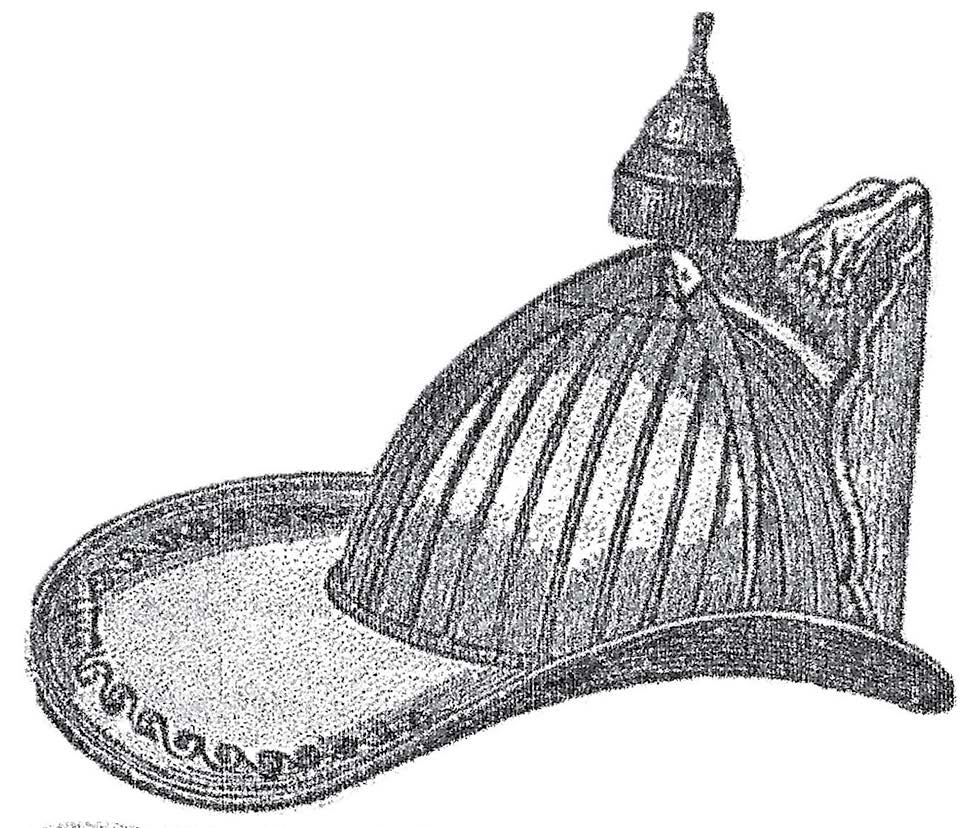
As fire companies took pride in their hand-pump fire apparatus, the custom to “dress up” the apparatus became prominent. This included painting in bright colors, ornamenting (stripping), and the plating or polishing of brass hardware. For more information on the “ornamentation” or “embellishment” of fire apparatus, see the Chapter: The Color Red in the American Fire Service in the A Part of Fire Service History series.24 The embellishment of a fire engine refers to the added final decoration of the apparatus that may include hand lettering, pin and line stripes (pin Striping), gilding (gold leaf), scroll work, and application of decals, as well as polished and decorated lamps, tools, and equipment.
This ornamentation included adding mounted lighting to illuminate the apparatus for night parades, fire responses, or working around the apparatus at fire scenes. These devices began as simple mounted lanterns or lamps of tin housings with mica panels (translucent silicate a substitute for glass). They soon advanced to brass or copper housings with glass panels. To add to the embellishments, the brass could be silver or nickel plated, and the glass painted and engraved with fire company names or the apparatus company number.25 Apparatus lamp housings were more of a box shape with flat sides for glass, some with four sides and others designed as six-sided housings. Tops or chimneys of the lamp were round metal oval discs of multiple sizes. Some embellished lanterns had finials representing different figures, the most common being an eagle.26 Some of the more highly embellished apparatus lamps were made for parades only and removed afterwards, with more utilitarian lamps used on the apparatus for responding to fires.27
Lamps used as headlights generally had polished reflectors behind the flame compartment to provide a focused beam of light forward. Some early lamps had candles inside them for light. Later models had fuel containers with regulated wicks to light and control the lamp. There were numerous makers of apparatus lamps, as well as some manufacturers’ designs holding patents.
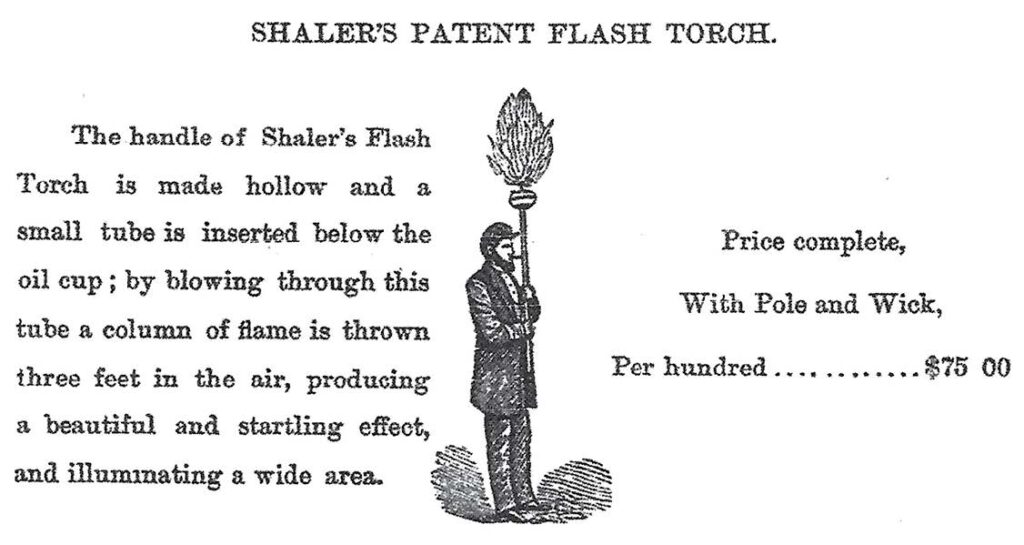
Lamp design and embellishments became true works of art during the days of steam fire engines. However, soon these horse-drawn steamers would be replaced by motorized fire apparatus. With this new era would also come changes in fire apparatus lighting. The electrical bulb powered by the battery/generator on the motorized apparatus would replace oil and kerosene-fueled individual lamps with electrical systems powered lamps. Though these lamps could be embellished with chrome rings and polished housings, they became more utilitarian over time. These new electrical lamps provided more brilliant lighting, less maintenance, and on/off switching. This was a major improvement over the original oil lamps that had to be routinely filled with fuel, have wick and globe maintenance, and then each one had to be hand-lit when responding to fires at night. Though the new electric lights were effective and safer, the new lighting of motorized fire apparatus no longer had the unique splendor of the former days of man or steam-powered fire apparatus.
Though the new motorized fire apparatus with electric lights would replace the embellished apparatus lamps, the simple lantern would continue to hold a place in the fire service for the next several decades. The dependable hand lantern would see a service life competing well against the new battery and bulb-operated flashlights for fireground lighting purposes. A well-maintained and fueled lantern would always be ready for service compared to the fragile early bulbs and limited-life batteries of the early flashlights. American LaFrance Fire Engine Company, Inc. continued to provide two Dietz Fire Department lanterns as standard equipment on their various models of motorized fire apparatus through the 1920s.28
Cautions on Torches, Lanterns, and Lamps
It is fairly common to see antique fire service lighting devices that have been cleaned and restored by museums and collectors. In some instances, the complete and correctly restored lights may be fueled and lighted for unique display purposes. However, one should be knowledgeable in the type and use of the devices and the fuel it was designed to use. Each device was constructed for use with a specific type of wick and fuel. Fuel with too low a flashpoint for the design of the lantern can cause flame runaway and overheat the fuel container, which may cause excess fuel vapor with potential for explosion. Flash point, viscosity, and purity of the type of fuel are all important in matching the proper fuel to the lantern or lamp being used.29 Always remember that the combustion process can generate soot and carbon monoxide and should only be used in properly ventilated areas. In addition flame flame-producing torches, lanterns, and lamps should be kept away from flammable materials and never left unattended when in use.30
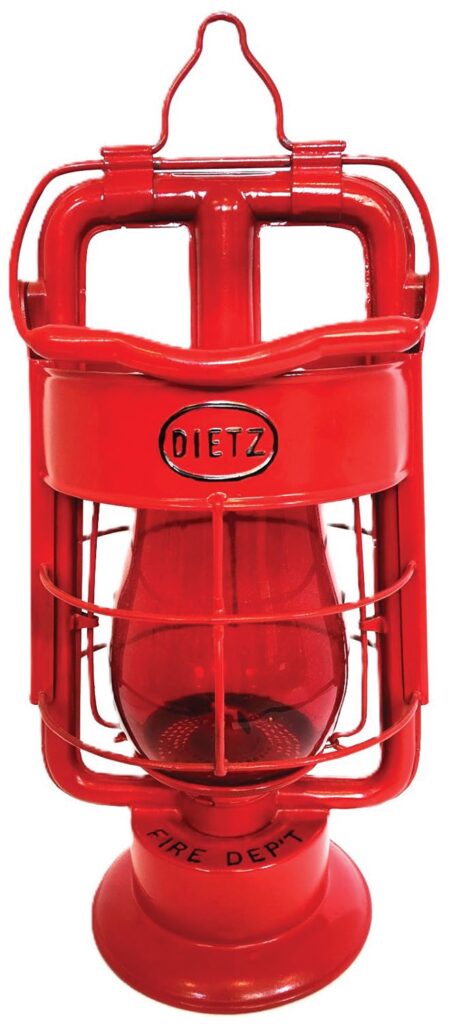
Old lanterns like the Dietz Fire King were durable and dependable, but they required proper maintenance and servicing during their service life. After use and over time, moisture could collect in the down tubes and fuel cup and cause corrosion and weak spots. All torches, lanterns, and lamps should be properly inspected before attempted use. This chapter does not provide the necessary knowledge and practical training experience to teach one how to safely repair or operate historic fire service torches, lanterns, or lamps, nor should it be substituted for appropriate instruction and apprenticeship under the supervision of a qualified and experienced equipment historian.
Lanterns and especially ornate apparatus lamps are generally highly valued and somewhat easy to remove from apparatus; they are easy items to disappear from antique apparatus. Because of this, fire museums and departments should take precautions to protect and preserve the loose equipment on restored antique fire apparatus or in displays.
Historic fire torches, lanterns, and lamps can be found for sale in antique shops, auctions, or online markets. In recent years, reproductions have been made and sold. Unfortunately, these reproductions can be artificially aged with salts or vinegar agents to give them a perceived antique patina. Firefighters and collectors should be careful of reproductions that may be passed off as historic or vintage artifacts.
The Fire Scramble and the Fireman Torch
An important historical aspect needs to be recounted about torches and their symbolic imagery seen in the fire service. Because the fireman’s torch was considered an essential tool to the early fire brigades and fire companies, a depiction of it was added to early fire service emblems or insignia, giving it a place of prominence. An example of a fire service emblem is the “Firefighter Scramble”, which is a pictorial interlocking grouping of fire service tools. The term scramble has a variety of meanings found in dictionaries and references on the internet. To better understand the term scramble as related to the fire service, we need to dig deeper to see how it developed over time.
Heraldic and Military Emblems
Arnold Whittick, in his book Symbols Signs and There Meaning, relates that symbols in many of today’s emblems have a historical beginning that can be traced back to symbols used in heraldry.31 Heraldic imagery is considered to have influenced the development of military insignia. Though European military insignia may better reflect this, early American military insignia were fairly plain. This is especially true up to the time of the American Civil War.
During the American Civil War, both the Union and Confederate Armies used various emblems to represent what unit or specialization to which they were assigned. An example of specialization or branch emblems might be crossed sabers for cavalry or crossed cannons for artillery. The Infantry wore a hunting horn emblem up until 1875, when they switched to crossed muskets.32 So symbols of tools of the trade were used in some cases to represent the soldier’s military assignment.
Though military insignia may have had some impact on firemen’s insignia, the first fire scrambles, at least in printed engravings, showed up prior to the Civil War. One part of heraldry symbolism that may have carried over to the fireman scramble was having equipment crossed in the center of the emblem. Chief Ronny Coleman related in his article The Badge that according to heraldry, crossed swords on an insignia represented “a person had gone to battle” or “it indicated a performance.”33 This relates to the symbolism of the Fireman scramble in that the pieces of equipment used in firefighting are grouped crossing each other in the center of the emblem showing they are used by the individual to battle fire.
Though research found that generally all the references referred to this Fire Service insignia being discussed as a “scramble”, Coleman used the term “Firefighter’s Cluster” when speaking about the unique emblem.34
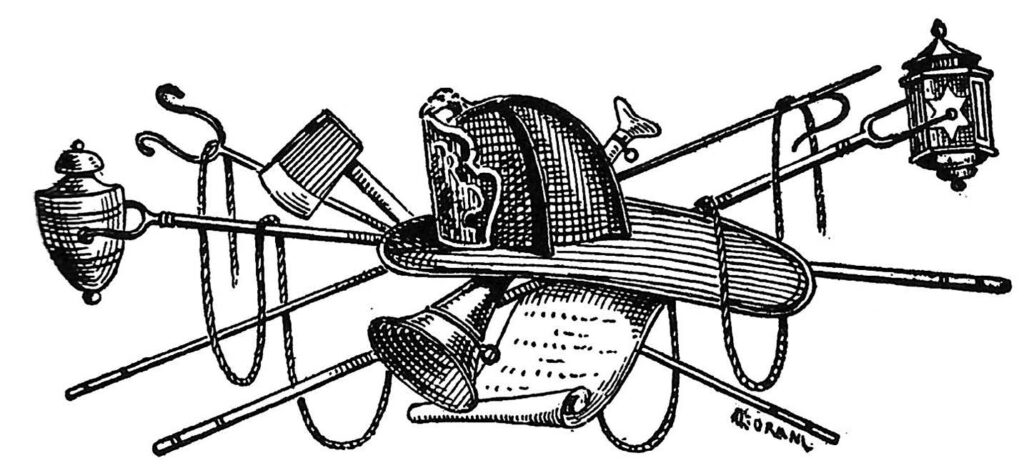
Defining the Term Scramble
The general term scramble first came into use in the late 1500s and may have derived from the word “scramb” meaning to “pull together with the hands.”35 Overtime it has had various definitions, but one that relates to firefighters is “to move with urgency.”36 Back in the early days of the American Fire Service, firemen would be said to scramble when alerted by a fire alarm, gathering their tools and responding with haste to the fire. Also, a more regrettable aspect of the days of the early American Volunteer Firemen was the competition to be first on the fire, creating a rivalry between various independent fire companies. The firemen from a different fire company might scramble to control the nearest fire hydrant or “plug” for their engine company, actually fighting over it.
Unfortunately, fire service terminology dictionaries and other references do not contain an actual definition for the term fire scramble. In theory, all firefighters know what a fire scramble looks like, but do not know how to define it, nor its historic development. The author will use a working definition for the term as: “an illustrated interlocking grouping, usually in a circular display, that depicts various tools of the trade (historical or current) used by firefighters.”37
When the term was first used to represent the pictorial image or emblem of a firefighter scramble is difficult to pin down. Images of scrambles appeared in the 1700’s probably first as engravings used to print illustrated images on fire service ephemera such as firemen’s certificates or fire company social invitations. Later, the scramble would show up on metal insignia or be used in the center of badges. An example of ephemera with a scramble including a torch was found on a printed certificate for “Firemen of the City of New York” dated 1847, during the volunteer era.38 When the New York State Legislature enacted legislation creating the Metropolitan Fire Department (MFD) for the City of New York in 1865, both the Seal of the MFD and their first badges contained a fire scramble at the center.39 However, both were different in appearance and neither one contained a torch image in the scramble.
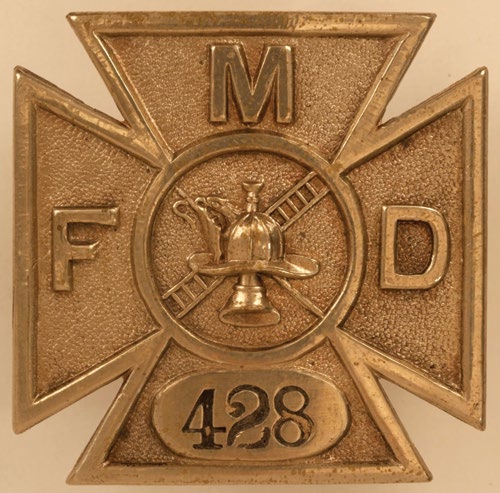
As has been shown in previous chapters, the volunteer fire companies of New York and the surrounding communities implemented and popularized many fire service traditions that would spread throughout what would become the United States. Examples are the iconic New Yorker style (Gratacap) fire helmet, speaking trumpets, and Maltese Cross emblems and badges. With the Fire Department of New York (FDNY) leading the way in 1870, smaller city departments around New York City incorporated scrambles in the center of their badges that contained torch images, such as Bay Ridge FD and Coney Island FD in the 1880s.40
So, when did the actual term “scramble” come to be a common word applied to the image firefighters know today? The scramble back in the beginning might have been called a fireman’s emblem, insignia, or illustrated grouping of tools. Various artist renditions of the scramble during this period were commonly found on paper documents such as firemen’s certificates or fire insurance policies. Today, artists might call it an illustration or graphic depiction of firefighting tools. According to the internet (artificial intelligence), these composite images or types of illustrations of implements representing a business or profession were common during the 19th Century, but give no name to the graphic display. Over time, it has become known as the fire or firefighter scramble as related in the above treatise. The name at some point stuck, becoming part of the fire service lexicon and tradition, and its remains so today.
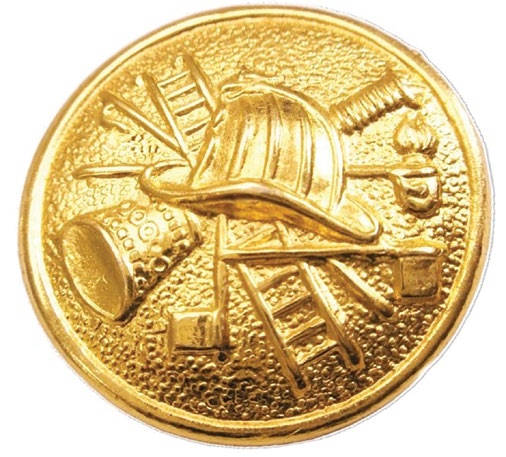
Tools in the Scramble
Early fire scrambles used in collar emblems or centered on badges contained a collage of various fire tools and equipment found in the fire service at the time. A traditional scramble might contain a side depiction of a traditional fire helmet centered over an upright ladder. Other various tools, such as a straight bore nozzle (play pipe) and a speaking trumpet, crossing each other. In addition, a pike pole and a torch pole were commonly crossed in the center as well. Finally working our way back around to early lighting and their symbols in the fire service. Later versions would add axes and other tools, with some removing the fire torch.
Each tool, besides its normal use as a firefighting implement, has been given a symbolic meaning by various people and generations of firefighters. From rescue to forcible entry, or preparedness to leadership, various symbolic definitions have been put forth over the centuries. The author leaves it up to the reader to research the historic symbolism of each, except for the firemen’s torch. That will be covered in the next section.
Various styles or revisions of the firefighter scramble continue to be used today as a fire service emblem. The historic scramble was found in paper ephemera (books, documents and certificates), banners, flags, collar buttons, and at the center of badges. Usually, on modern badge centers, the fire scramble represents the rank, Firefighter, though it can be used as a general fire service emblem representing all fire service ranks.
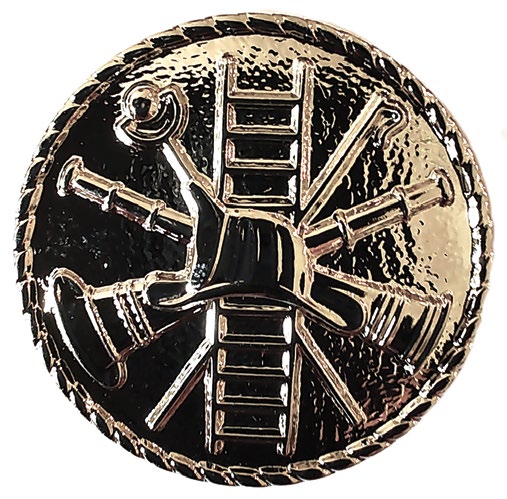
Getting it Right
So why are we discussing scrambles in this chapter on early fire service lighting? In the historic fire scramble, one of the pieces of fire service equipment that was depicted was the torch. On drawings or engraved printing, the torch image (torch pole, or pole lantern) is well depicted and easy to see what the image represents. On metal badges or small cloth patches, the equipment images are reduced and more stylized to fit. In this instance, the torch is usually depicted as a circular (ball) container supported by a “Y” bracket on a pole (sometimes described as resembling a ball and crutch). A few images (usually from an older period) actually have stylized flames depicted coming from the torch (ball) container.
Sadly, a significant number of firefighters have been poorly educated on fire service history and traditions. It is absurd that a number of firefighter’s forums or blogs on the internet relate the belief that the torch symbol in the scramble is not a torch but some sort of battering ram, window breaker, or command symbol.41 Others have related that they thought it was a religious incense container related back to the origins of the Fire Service Maltese Cross. The actual name for a religious incense burner is a thurible or censor.42 However, as has been shown in these treaties, the symbol in the firefighter scramble actually represents a torch used to light the way in the early history of the fire service. Some later scrambles found in historic drawings and banners may depict the pole lantern instead of the simple open torch.
It is a sign of the times that the iconic fire torch has been dropped from most of the modern fire scrambles, apparently because it is assumed to have no relevance to today’s fire service. However, back in the early days of the American Fire Service, the fireman’s torch was an essential tool used for warnings and night responses. Used to light the way for the fire company, it has become an iconic symbol of the beginnings of the American Fire Service. Today, the fire torch symbolizes the era of the volunteer firemen and illuminates their prominent place in the history and traditions of the American Fire Service.
Now you know the true story of the fireman’s torch and the torch symbol when depicted in firefighter scrambles. So please take pride in our profession’s history and share the true facts concerning the past origins of fire service equipment, symbols, and traditions.
The Legacy of History and Traditions
The introduction of lighting devices in colonial America and their continuing advancements were a major leap forward in firefighting technology. It initiated safer responses in the night streets and provided operational lighting on-scene. Firemen adapted current technology to their needs for firefighting purposes, enabling a way to control hazards using the flame of fire that provided the necessary light for aggressive response and extinguishment at night fires, better protecting lives and property night and day.
These lighting devices, specifically the torch and later the lantern, would be seen as essential tools of the firefighting occupation. The torch bearer for the early American fire companies would become an iconic image of the volunteer firemen leading the way to protect life and property. As such, they would become symbols that would define the tasks and mission of the American Fire Service. They remain part of the ongoing customs as seen in some of the fire service scramble emblems that are proudly displayed on badges, banners, and throughout our history and traditions.
Historian David McCullough related in a speech at Wesleyan University in 1984 that History is who we are and why we are the way we are.43 Though McCullough’s remarks were not made specific to the fire service, they eloquently state why the history of the fire service defines us and establishes our living traditions. It is this history and tradition foundation that guides us into the future and the continuing fulfillment of the Fire Service mission.
Authors Comments
The author wishes to recognize and thank the fire service personnel and organizations for their assistance in the development of this article. In particular, the author expresses his appreciation to:
Curtis Peters, Board Chair, Vintage Fire Museum, Jeffersonville, IN; and the University of Missouri Ellis Library/Lending Library for assisting the author in obtaining the inter-library loan of various research documents and archival materials.
The author also wishes to recognize all the various Historians and Authors for their extensive and invaluable work in Fire Service History through artifact notes, articles, and books that have been used for research purposes by the author and footnoted in this series. May their work continue to endure the ages and preserve the true history and traditions of the American Fire Service.
The A Part of Fire Service History Series articles are copyrighted © 2023 – 2025 by the author and are published under permission granted to the FFAM.
Endnotes
- “Fireman”, Online Etymology Dictionary, © 2001-2023 Douglas Harper, website accessed September 3, 2023, https://www.etymonline.com/word/fireman#:~:text=fireman%20(n.),of%20a%20early%20steam%20engine.
- Noah Webster, LL.D., American Dictionary of the English Language, “Fireman”, Revised Edition, White & Sheffield, New York, 1841, p. 341.
- “History of street lighting in the United States, Lamp Light, 2023 LampLight, LLC, web article accessed July 9, 2025: https://lamplightdecorativelighting.com/industry-news-blog/history-of-street-lighting-in-the-united-states/#:~:text=The%20earliest%20street%20lights%20in,city%20street%20lights%20in%201809.
- Ibid.
- Arnold Merkitch, Early Fire Helmets, Self-published, West Islip, NY, First edition, 1981, p. 71.
- Chuck Deluca, “Lighting, Chapter 1”, Fire House Memorabilia, A Collectors Reference, Publication of Maritime Antique Auctions, York, Maine, Published by Creative Printing, Ogunquit, Maine, 1990, p. 2.
- Arnold Merkitch, Early Fire Helmets, p. 71.
- Glenn Corbett, “Fire Service History on Display at Parade”, October 6, 2016, Fire Engineering, web article accessed July 22, 2025: https://www.fireengineering.com/firefighting/corbett-fire-helmet/.
- Thomas Plank, “They Marched with Torches: Getting Out the Vote, 1840-1900”, Smithsonian, National Museum of American History, Washington, DC, Feb. 29, 2016, web article accessed July 22, 2025: https://americanhistory.si.edu/explore/stories/they-marched-torches-getting-out-vote-1840-1900.
- Harold Turrentine, Editor, “History of the Chicago Fire Department”, Chicago Fire Department, Training Division, 2004, p. 5. Web article accessed July 30, 2025: chrome-extension://efaidnbmnnnibpcajpcglclefindmkaj/https://www.chicago.gov/content/dam/city/depts/cfd/general/PDFs/HistoryOfTheChicagoFireDepartment_1.pdf.
- “Improved Hat Torch”, Catalogue of Standard Equipments and Supplies for Firemen, No. 18, Cairns & Brother, New York, NY, 1890s. p. 39.
- “Shaler’s Patented Flash Torch”, Fred Millers Fire Apparatus and Fire Department Supplies, Brooklyn, New York, 1872, p. 24.
- “Lantern.” Merriam-Webster.com Dictionary, Merriam-Webster, https://www.merriam-webster.com/dictionary/lantern. Accessed 10 Jul. 2025.
- Ibid.
- Catalogue of Standard Equipments and Supplies for Firemen, No. 18, Cairns & Brother, p. 36.
- “Breaking the Fire Lantern Color Code”, Fire Lantern History Display, Vintage Fire Museum, Jeffersonville, IN.
- “Catalogue of Standard Equipments and Supplies for Firemen”, No. 18, Cairns & Brother, p. 36.
- R. E. Manufacturing Company, “Dietz King Fire Department” (2021), Morehead History & Railroad Museum Lantern Collection. 63, web article accessed July 11, 2025: https://scholarworks.moreheadstate.edu/mh_and_rm_artifacts/63.
- Catalogue of Standard Equipments and Supplies for Firemen, No. 18, Cairns & Brother, p. 36.
- James Piatti and Sandra Frost Piatti, Firefighting Antiques & Memorabilia, Schiffer Publishing, Alglen, PA, 2001, p. 107.
- John V. Morris, Fires and Firefighters, p 145.
- Paul Ditzel, Fire Alarm, The Fascinating Story Behind The Red Box On The Corner, Publisher Fire Buff House Division of Conway Enterprises, Inc., New Albany, IN, 1990, p. 15.
- Ibid.
- David E. Hedrick, “The Color Red in the American Fire Service, A Part of Fire Service History”, FFAM Magazine, Fire Fighters Association of Missouri, Warrensburg, MO, March/April 2024, Vol. 67, Issue 2, p 8–10, 26-34.
- Chuck Deluca, “Lighting, Chapter 1”, Fire House Memorabilia, A Collectors Reference, p. 1.
- James Piatti and Sandra Frost Piatti, Firefighting Antiques & Memorabilia, Schiffer Publishing, Alglen, PA, 2001, p. 107.
- Ibid.
- “Fire Fighting Apparatus, Catalog No. 20”, American LaFrance Fire Engine Company, Inc., Elmira, NY, 1923, p. 7-21.
- W. T. Kirkman, “What fuel can I use in my Oil Lamp or Oil Lantern?”, W.T. Kirkman Lanterns, Ramona, California, copyright 1997-2024, web article accessed July 10, 2025: https://lanternnet.com/lantern-lamp-fuel/.
- “Candle and Oil Lamp Safety”, Be Ready Utah, Utah Department of Public Safety, Division of Emergency Management, 2006, web article accessed August 17, 2025: https://beready.utah.gov/family-preparedness/12-areas-of-preparedness/light-power/candle-safety/#:~:text=Oil%20lamp%20or%20lantern:%20The,and%20pets%2C%20and%20anything%20combustible.
- Arnold Whittick, Symbols Signs and There Meaning, Leonard Hill Books Limited, London, 1960.
- Dr. Howard G. Lanham, “Evolution of U.S. Army Infantry Insignia”, American Military Patches, Other Insignia and Decorations of World War Two, 2011, Web article accessed August 3, 2025: https://hglanham.tripod.com/usinfantry/infantry1.html.
- Ronny J. Coleman, “The Badge”, Chief’s File Cabinet, Fire Services Training Institute, p. 2, web article accessed August 6, 2025: chrome-extension://efaidnbmnnnibpcajpcglclefindmkaj/https://www.cafsti.org/wp-content/uploads/Badge.pdf.
- Ibid, p. 3.
- Harper Douglas, “Etymology of scrambler,” Online Etymology Dictionary, accessed July 29, 2025, https://www.etymonline.com/word/scrambler.
- “Scramble.” Merriam-Webster.com Dictionary, Merriam-Webster, https://www.merriam-webster.com/dictionary/scramble. Accessed 27 Jul. 2025.
- A composite definition for the term “Fire Scramble” as defined by the author.
- Augustine E. Costello, Our Firemen, A History of the New York Fire Departments, Volunteer and Paid, Augustine E. Costello publisher / New York, 1887, p. 129, Accessed through Internet Archive, August 4, 2025: https://archive.org/details/ourfiremenhistor00cost/page/n7/mode/2up.
- Costello, p. 783.
- Gary R. Urbanowicz, Badges of the Bravest, Turner Publishing Co., Paducah, KY/M.T. Publishing Co., Inc., Evansville, IN, 2002/03, p. 42, 43.
- Examples of internet misinformation: “History lesson needed-FF Scramble”, Firehouse Forums, 1998-2023, web page forum: https://forums.firehouse.com/forum/meet-and-greet/meet-and-greet-aa/12586-history-lesson-needed-ff-scramble.
- E.A. Livingstone, The Concise Oxford Dictionary of the Christian Church, Third Edition, “thurible”, Oxford University Press, 2013, p. 565.
- Thomas McGregor, “Historian David McCullough”, Medium, Mar 12, 2023, web article accessed July 23, 2025: https://realtmcgregor.medium.com/historian-david-mccullough-cc29153fb114.


